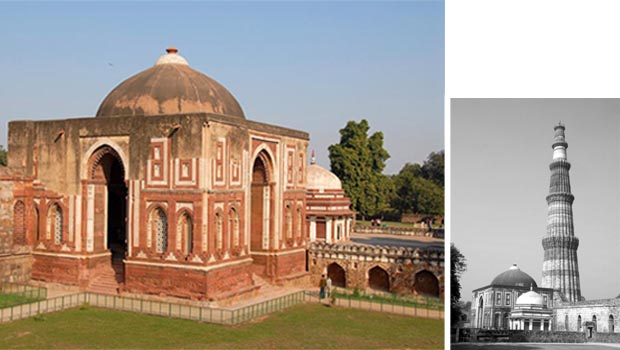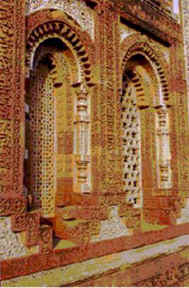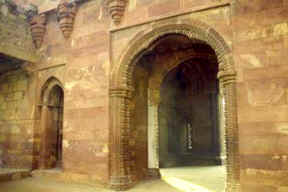After Shams-ud-Din Iltutmish, the Delhi Sultanate was marked by a long period of brief rules and frequent internecine warfare. This interregnum was to last for almost sixty years before any stable government could be re-established. Not surprisingly, there was little in the way of building achievement except for a few scattered tombs at Multan. The wars of succession and coronation left little scope to devote time or energy to artistic and architectural patronage.
Some fifty years after Iltutmish, the Khiljis, a dynasty of Afghanized Turks from Ghazni, seized power in Delhi. With the third in the line, Ala-ud-Din (A.D. 1296-1316) a stable government was at last installed in Delhi. Ala-ud-Din was a prodigious builder whose appetite for building was matched by his prowess in war. His most notable efforts, apart from shifting his capital from Lal Kot to Siri, were again to be found at the site of the Qutb Minar - which by its very magnificence had become over the years both an inspiration as well as a challenge to do better.
The Great Alai Minar
Ala-ud-Din, true to form, felt compelled to increase even further the size of the Quwwatu'l Islam mosque. His scheme called for increasing the size of the enclosure four times, providing ceremonial entrance gateways on each side, and a great minar, twice the size of the Qutb - the Alai Minar.
It would have been clear to anyone less megalomanic - 'with a vision less obscured by self-exaltation 1 - that such a grandiose project would be impossible in the Sultan's lifetime. Indeed, the Alai Minar today is a stump (albeit a magnificent one - we can well imagine the proportions of the tower had it ever been finished), its rubble core clearly showing as it rises up to one story.
The Alai Darwaza
The only part of Ala-ud-Din's scheme which was completed was the southern ceremonial entrance - named the Alai Darwaza after its builder. It is clear from its appearance and construction that a fresh new influence was at work - this is a piece of Muslim architecture hitherto unknown in India.

Historians have traced its genealogy to the architecture found in Asia Minor under the rule of the Seljuks in the early centuries of the second millennium. The breakup of the Seljuk empire under the weight of Mongol invasions caused craftsmen and builders to be scattered far and wide, and among the places offering sanctuary was the Delhi Sultanate. Because of its revolutionary construction, the Alai Darwaza served as a model for many of its successors.
The first innovation in the gateway was the system of walling, alternating between one course of stretchers - stone laid with its longer ends facing outward - and one course of headers - stone laid with its longer end going deep into the wall. The header course enabled the walling to penetrate into the rubble core and thus make the wall as a whole stronger. This method of walling was to continue and was a typical characteristic of Mughal building.
 The second innovation was the true arch. 2 This imported arcuated tradition was to play an important role as it was to provide the prototype for successive Sultanate tombs.
The second innovation was the true arch. 2 This imported arcuated tradition was to play an important role as it was to provide the prototype for successive Sultanate tombs.
In form the Alai Darwaza is a rectangular building on high plinth into which steps have been cut to access the interior. The three outer faces are very similar with a tall arch over the steps. The plinth is carved in bands, and the wall surface above is divided into two stories, each further subdivided into rectangular panels. The lower of these panels have a recessed arch while the upper ones into smaller rectangles. At each point, the articulation is marked by a mixture of sandstone and marble arabesque and decorative carving.
However, by far the most imposing feature of these facades is the central arch, rising to nearly the whole height of the structure. In shape it is rare - a horse-shoe or keel arch. Around its outer rim is a band of inscribed white marble. The intrados or the inner rim of the arch shows its most distinctive feature - a fringe of lotus-bud carving. 3
 The inner façade, facing the mosque and Qutb Minar, is different. For one, the opening is not a keel arch but a true semi-circular one, and for another it is clear that in its sensual and plastic decoration the indigenous craftsman was given a much freer hand.
The inner façade, facing the mosque and Qutb Minar, is different. For one, the opening is not a keel arch but a true semi-circular one, and for another it is clear that in its sensual and plastic decoration the indigenous craftsman was given a much freer hand.
The interior of the structure is no less remarkable for its technological innovation. First started in the tomb of Iltutmish (see previous article), the weight of the dome is transferred to the square base by the same mechanism - the squinch. In this case, the squinch consists of five recessed arches gracefully transforming the square into the octagon, and the octagon into a sixteen sided figure.
Among the other architectural work of Ala-ud-Din, little remains except fragmentary and crumbling structures. And though the work of the Khiljis was not entirely confined to the capital city of Delhi, the influence of local workmen in the provinces and the eventual decline of the Khilji dynasty meant that these were never as remarkable nor of as high a standard as the Alai Darwaza at the Qutb.
1. Brown, Percy Indian Architecture (Islamic Period) D.B. Taraporevala Sons and Co. Pvt. Ltd. Bombay, 1975, p.16
2. This was not the first time that a true arch had been used in India - it had been used in Balban's tomb before - but this time it was employed in a far more influential building.
3. This was originally thought to be a fringe of spear-heads but now are generally accepted as lotus buds.

 The second innovation was the true arch. 2 This imported arcuated tradition was to play an important role as it was to provide the prototype for successive Sultanate tombs.
The second innovation was the true arch. 2 This imported arcuated tradition was to play an important role as it was to provide the prototype for successive Sultanate tombs.  The inner façade, facing the mosque and Qutb Minar, is different. For one, the opening is not a keel arch but a true semi-circular one, and for another it is clear that in its sensual and plastic decoration the indigenous craftsman was given a much freer hand.
The inner façade, facing the mosque and Qutb Minar, is different. For one, the opening is not a keel arch but a true semi-circular one, and for another it is clear that in its sensual and plastic decoration the indigenous craftsman was given a much freer hand.